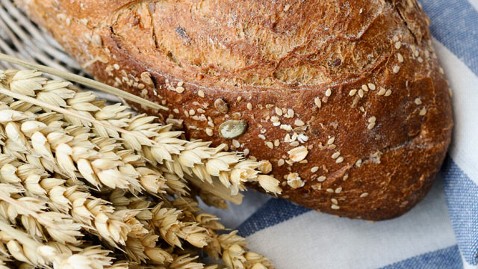A Guide to Decoding Ingredients on Grain Products

Image Credit: Getty Images
Claims on the front of packages such as "whole grain," "multigrain" and "12-grain" have been given no legal definition given by the Food and Drug Administration. That means manufacturers are fairly free to use them as bragging points, even if their products contain more refined white flour than whole grain.
That's why consoumers need to go to the back of the package and look at the list of ingredients, which are listed in order - from most to least - of what's in the product. If you want more whole grains in your diet, make sure the first ingredient in the foods you eat is a whole grain.
Simple, right? Actually, no. For example "wheat flour" means "white flour." What? Yep, only whole wheat flour means … whole wheat flour. So below is a glossary of terms to help you decode ingredient lists and add more whole grains to your diet.
Terms that mean "whole grain": Whole wheat: If you see the term "whole wheat," that is the only time you are getting whole grain wheat flour. It includes all parts of the grain, including the germ, the endosperm and the bran.
100 Percent Whole Wheat: A more emphatic description of the above.
Whole Wheat Bread: This is the only whole grain product that must be made with 100 percent whole wheat flour to be labeled "Whole Wheat bread."
100 Percent Whole Wheat Bread: Ditto
Wheat bran: A natural source of fiber.
Oat bran: Another natural source of fiber.
Terms that do not mean whole grain:
Wheat flour: This is refined white flour. White flour is missing the germ and the bran.
Enriched white flour: This is refined white flour, with some nutrients added back in.
Unbleached white flour: This is refined white flour.
Bleached wheat flour: White flour.
Wheat bread: Because it's not called " Whole wheat," just "wheat, this is almost certainly white bread, with little or no whole grain flour.
Whole grain: Seeing "Whole grain" on food labels doesn't necessarily mean that the product is mostly whole grain; it may be mostly white flour.
"Made with whole grains: Often these products contain even less whole grain. Check the ingredients list to see if whole wheat flour or another whole grain is the first grain listed in the ingredients list.
Multigrain: This means the food contains more than one type of grain, but it may be all be refined flour, which are not as beneficial to your health. None may be whole grain.
Stoneground: Stoneground has no legal definition, so it's basically meaningless.
High in Fiber: Many manufacturers add synthetic fiber to their products, or fiber from other sources, so check for ingredients like "maltodextrin" and "inulin," also known as chicory root fiber, oat hull fiber, oat fiber, wheat fiber and wheat starch.